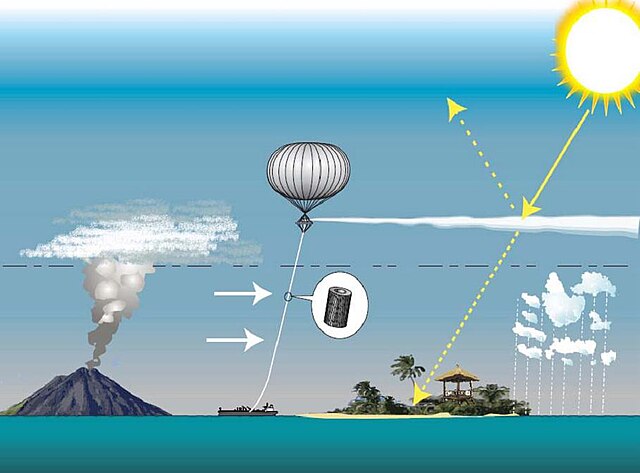Stratospheric aerosol injection
Stratospheric aerosol injection is a proposed method of solar geoengineering to reduce global warming. This would introduce aerosols into the stratosphere to create a cooling effect via global dimming and increased albedo, which occurs naturally from volcanic winter. It appears that stratospheric aerosol injection, at a moderate intensity, could counter most changes to temperature and precipitation, take effect rapidly, have low direct implementation costs, and be reversible in its direct climatic effects. The Intergovernmental Panel on Climate Change concludes that it "is the most-researched [solar geoengineering] methodagreement that it could limit warming to below 1.5 °C (2.7 °F)." However, like other solar geoengineering approaches, stratospheric aerosol injection would do so imperfectly and other effects are possible, particularly if used in a suboptimal manner.
Acid rain-damaged forest in Europe's Black Triangle
Governmental action to combat the effects of acid rain
Proposed tethered balloon to inject aerosols into the stratosphere
This graph shows baseline radiative forcing under three different Representative Concentration Pathway scenarios, and how stratospheric aerosol injection, first deployed in 2034, can be tuned to either halve the speed of warming by 2100, to halt the warming, or to reverse it entirely.
Solar radiation modification
Solar radiation modification (SRM), or solar geoengineering, is a type of climate engineering in which sunlight would be reflected back to outer space to offset human-caused climate change. There are multiple potential approaches, with stratospheric aerosol injection being the most-studied, followed by marine cloud brightening. SRM could be a temporary measure to limit climate-change impacts while greenhouse gas emissions are reduced and carbon dioxide is removed but would not be a substitute for reducing emissions.
SRM can be deployed on different scales. This graph shows the baseline radiative forcing under three different Representative Concentration Pathway scenarios, and how it would be affected by the deployment of SAI, starting from 2034, to either halve the speed of warming by 2100, to halt the warming, or to reverse it entirely.
Potential complementary responses to climate change: greenhouse gas emissions abatement, carbon dioxide removal, SRM, and adaptation. Originally called the "napkin diagram" and drawn by John Shepherd.
Modeling evidence of the effect of greenhouse gases and SRM on average annual temperature (left column) and precipitation (right column). The first row (a) is moderately high continued greenhouse gas emissions (RCP4.5) at the end of the century. The second row (b) is the same emissions scenario and time, with SRM to reduce global warming to 1.5 °C. The third row (c) is the same emissions scenario but in the near future, when global warming would be 1.5 °C, with no SRM. The similarity between the second and third rows suggests that SRM could reduce climate change reasonably well.
Stratospheric Particle Injection for Climate Engineering







